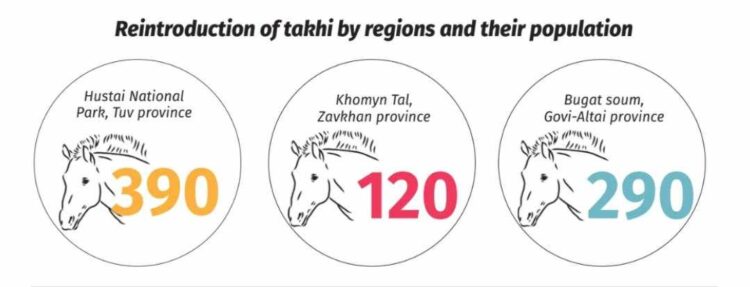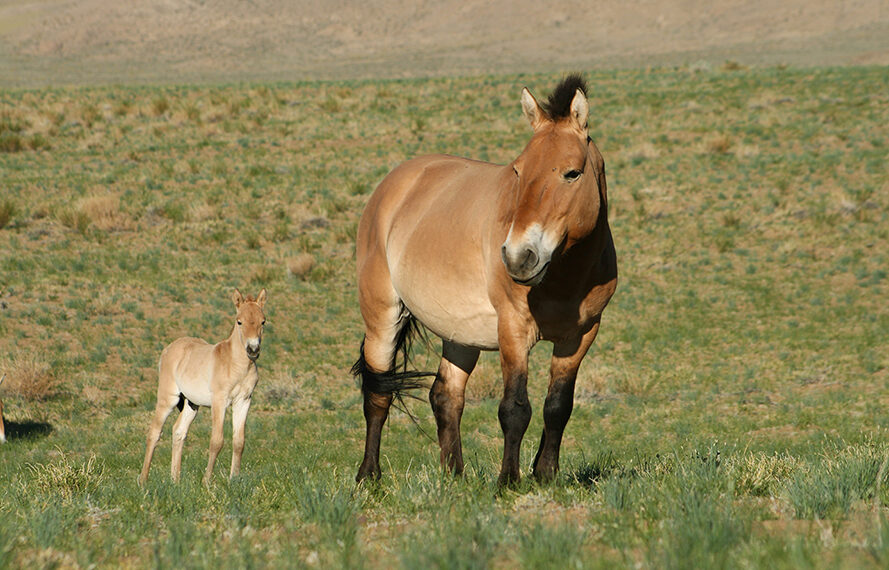Wildlife numbers are on a rapid decline due to changes to the ecosystem related to a num- ber of issues such as global warming and climate change, mining activity, infrastructure develop- ment, agriculture, animal husbandry and poach- ing. A clear example of this is the Przewalski horse (in Mongolian known as ‘takhi’), the world’s only wild horse that once roamed the Mongolian Gobi, and their numbers have declined sharply since the middle of the last century and by the 1960s it was no found in the wild, only a small number of takhi were left in foreign zoos. Scientists, individ- uals and organizations who love nature worked together to save this unique species of wild horse from extinction and successfully managed to rein- troduce it to its native country of Mongolia.
The fact that takhi could survive the harsh climate of Mongolia, while they had been away from the wild for almost a century, was a ques- tion many scientists struggled with. However, as a result of the hard work and the struggle of non-governmental organizations, scientists and researchers working to reintroduce and protect the takhi, those doubts soon disappeared, and the wind, soil and grass of the area were perfectly adapted to takhi, proving it to be a native animal of Mongolia. The successful reintroduction of takhi is a major contribution of Mongolians to the protection and reintroduction of large mammals.
This year marks the 30th anniversary of the reintroduction of Przewalski horses. Currently, there are about 850 Przewalski horses in Mongolia in three separate regions. One of those regions, Khomyn tal, was selected as the reintroduction site for horses and preparations began back in 1999. Consequently, in 2004 the French Association for Przewalski horses and the World Wide Fund for Nature launched a reintroduction and con- servation project to bring the first 12 takhi horses to Khomyn tal. In 2014, the ‘Khomyn talyn takhi’ NGO was established and it successfully assumed the honorable role of protecting the Przewalski horses. Today, the reintroduced Przewalski horse population has grown to more than 120.
This is the result of the multi-parties’ collaboration that initiated, supported and implemented this project. Khomyn Talyn Takhi NGO operates to study reintroduced Przewalski’s horses, protect their habitats, implement the land management of the newly established Khomyn Tal National Park, establish independent and sustainable conser- vation funding, and develop cooperation. This non-governmental organization is a real example of a good partnership in which the protection of state special protected areas is performed by management contracts, reducing the workload of the state and contributing to the country’s economy.
The reintroduction of the takhi did not end with the transportation and release of them into the wild. Therefore, the Khomyn Tal Takhi NGO conducts observations and research on the behavior, appearance and health of the rein- troduced Przewalski horses and protects their habitats. In addition, internal relations of the herd, behavioral monitoring, and the creation of a database, ensuring the integrity of the fence where the Przewalski horses were reintroduced, patrols and keeping livestock out are all part of their daily activities.

With the implementation of the Przewalski horses’ reintroduction program, local people have joined the network of active rangers, volunteered to participate in conservation activities such as patrolling, protecting forest resources and exchanging information. They consider the takhi as being valuable and having an appeal like one’s own. In order to protect the future habitat of the growing takhi herd, the Mongolian Parliament took 411,000 hectares around Khomyn tal under state protection as part of a National Park in May, 2020. In addition to protecting nature and wildlife, the Khomyn Talyn Takhi NGO is also actively in- volved in the future development of the area and improving the livelihoods of the local people.
For example, they developed and implemented Durvuljin soum’s sustainable development plan, established herder partnerships to improve the livelihoods of local people and generate addition- al income for herders, as well as supporting the export of their felt products to France. Moreover, in order to protect and use wild sea buckthorn resources, a small number of sea buckthorn processing factories have been established, and a certain percentage of the proceeds from the production of pure sea buckthorn oil and concen- trated juice for domestic and foreign markets is being spent on environmental protection. Furthermore, summer training for children of Durvuljin soum has been organized on a regular basis since 2010 in order to prepare the next gen- eration that is friendly to nature and fauna.
A child who participated in the first summer training has become a veterinarian and is working side by side with the Khomyn Talyn Takhi NGO team. This is the proud result of the summer training program. With the reintroduction of the takhi in Kho- myn tal, rare wild animals have been protected not only in Mongolia, but also in the world. A new census was undertaken to estimate the number of Mongolian Saigas and Dalmatian Pelicans, and about 150 saigas, 800 Mongolian antelopes, 40-50 black-tailed antelopes and about 70-80 ibexes were counted, which is a small increase in com- parison to previous years.
Although the reintroduction of the Przewal-ski horses has been successful, there are some challenges regarding conservation around Kho- myn tal National Park. For example, some people underestimate the value and the importance of protected areas and the overuse of pasture and water resources to raise livestock for personal gain without following the proper rules, is putting a lot of pressure on wildlife habitat. Besides, there are many people who have financial interests in mining and natural resources, and the law regu- lating them is relatively weak. It is also important to note that when reintroduced Przewalski horses’ numbers are relatively small and at a vulnerable level, there are some risks such as cross breeding with domestic horses and exposure to natural infectious diseases transmitted by livestock.
Consequently, in 2004 the French Association for Przewalski horses and the World Wide Fund for Nature launched a reintroduction and conservation project to bring the first 12 takhi horses to Khomyn tal. In 2014, the ‘Khomyn tal takhi’ NGO was established and it successfully assumed the honorable role of protecting the Przewalski horses. Today, the reintroduced Przewalski horse population has grown to more than 120.






